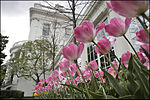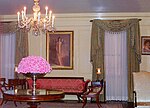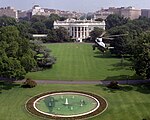Office of Trade and Manufacturing Policy
2017 establishments in Washington, D.C.Executive Office of the President of the United StatesPresidency of the United StatesSource attributionWhite House Office

The Office of Trade and Manufacturing Policy (OTMP) was an office established within the White House Office by former US President Donald Trump by Presidential Executive Order 13797 on April 29, 2017.During the Biden transition, the incoming administration made no signals towards filling the office, which has remained vacant as of the start of the Biden administration. It is presumed inactive.
Excerpt from the Wikipedia article Office of Trade and Manufacturing Policy (License: CC BY-SA 3.0, Authors, Images).Office of Trade and Manufacturing Policy
Treasury Annex tunnel, Washington
Geographical coordinates (GPS) Address Nearby Places Show on map
Geographical coordinates (GPS)
| Latitude | Longitude |
|---|---|
| N 38.897 ° | E -77.036 ° |
Address
Jacqueline Kennedy Garden
Treasury Annex tunnel
20500 Washington
District of Columbia, United States
Open on Google Maps











